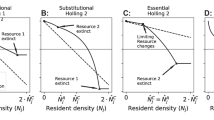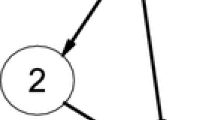Abstract
Incorporating cooperative interspecific interactions into the classical Niche Theory has been identified as a big challenge of population and community ecology. Attempting to fill this gap I present the Lotka-Volterra Niche Game Model (LVNGM), resulting from the marriage between the classical Niche Theory and Game Theory. I use this new framework to analyze the effects of including cooperative interspecific interactions on two global properties of a community, its aggregate biomass or total yield and its biodiversity, measured by the Shannon equitability. I consider different dilemma games, games for which neither pure competition nor pure cooperation are dominant/optimal strategies, which are popular in biology: the Prisoner's Dilemma (PD), the Snowdrift (SD) and the Stag-Hunt (SH) games. The main result is that these games lead to a higher total yield—which is maximum for the SD, followed by the PD and the SH in third place—and, generally, to a higher biodiversity than pure competition. LVNGM allows gaining insights into niche construction/engineering. Examples in which LVNGM can be applied range from several single-trophic natural communities, in which positive interactions have been detected, to overyielding of artificial polycultures and plant-pollinator networks.





Similar content being viewed by others
Data accessibility
All raw data used was obtained from bibliographic sources.
Notes
We use this terminology of cooperation and competition because it is standard in ecology. However, it might be a bit misleading from an EGT viewpoint, according to which strategies always compete with each other and the one who can collect higher payoff prevails. Thus, in that sense, it is worth stressing that the C strategy is competing too vs. D.
Notice that, by virtue of the formal equivalence between Lotka-Volterra equations and the replicator equation (Hofbauer and Sigmund 1998), the resulting niche games can thus also be interpreted as evolutionary games in which some strategies (species) go extinct at the equilibrium state.
We choose a probability of cooperation between 0 and 1 rather than 0 or 1 just for generality, the binary choice would also work.
References
Agrawal, A. A., et al. (2007). Filling key gaps in population and community ecology. Frontiers in Ecology and the Environment,5, 145–152.
Arbiza, J., Mirazo, S., & Fort, H. (2010). Viral quasispecies profiles as the result of the interplay of competition and cooperation. BMC Evolutionary Biology,10, 137.
Armas, C., Rodríguez-Echeverría, S., & Pugnaire, F. I. (2012). A field test of the stress gradient hypothesis along an aridity gradient. Journal of Vegetation Science,22, 818–827.
Axelrod, R., & Hamilton, W. D. (1981). The Evolution of cooperation. Science,211, 1390–1396.
Berendse, F. (1979). Competition between plant-populations with different root depths. 1 Theoretical considerations. Oecologia,43, 19–26.
Broom, M., & Rychtar, J. (2013). Game-theoretical models in biology (1st ed.). Boca Raton: Chapman & Hall/CRC Press.
Bruno, J. F., Stachowicz, J. J., & Bertness, M. D. (2003). Inclusion of facilitation into ecological. Trends in Ecology and Evolution,18, 119–125.
Callaway, R. M., & Walker, L. R. (1997). Competition and facilitation: a synthetic approach to interactions in plant communities. Ecology,78, 1958–1965.
Callaway, R. M., Brooker, R. W., Choler, P., et al. (2002). Positive interactions among alpine plants increase with stress. Nature,417, 844–848.
Chase, J. M. and Leibold, M. A. 2003. Ecological Niches. University of Chicago Press.
Dawes, R. M. (1980). Social dilemmas. Annual Review of Psychology,31, 69–93.
de Wit, C. T. (1960). On competition. Verslagen Landbouwkundige Onderzoekingen,66, 1–82.
Elton, C. (1946). Competition and the structure of ecological communities. Journal of Animal Ecology,15, 54.
Fort, H. (2014). Quantitative predictions of pollinators’ abundances from qualitative data on their interactions with plants and evidences of emergent neutrality. Oikos,123, 1469–1478.
Fort, H. (2015). Community diversity and total abundance: Quantitative predictions from competition niche theory. Ecological Complexity,21, 120–127.
Fort, H. (2018). On predicting species yields in multispecies communities: Quantifying the accuracy of the linear Lotka-Volterra generalized model. Ecological Modelling,387, 154–162.
Fort, H., & Mungan, M. (2015). Predicting abundances of plants and pollinators using a simple compartmental mutualistic model. Proceedings of the Royal Society B. https://doi.org/10.1098/rspb.2015.0376.
Fort, H., Scheffer, M., & van Nes, E. (2009). The paradox of the lumps mathematically explained. Theoretical Ecology,2, 171–176.
Fort, H., Scheffer, M., & van Nes, E. (2010). The clumping transition in niche competition: a robust critical phenomenon. Journal of Statistical Mechanics,2010, P05005.
Goldberg, D. E., Rajaniemi, T., Gurevitch, J., & Stewart-Oaten, A. (1999). Empirical approaches to quantifying interaction intensity: competition and facilitation along productivity gradients. Ecology,80, 1118–1131.
Halty, V., et al. (2017). Modelling plant interspecific interactions from experiments of perennial crop mixtures to predict optimal combinations. Ecological Applications,27, 2277–2289.
Hofbauer, M., & Sigmund, K. (1998). Evolutionary games and population dynamics. Cambridge: Cambridge University Press.
Hillerislambers, R., et al. (2001). Vegetation pattern formation in semi-arid grazing systems. Ecology,82, 50–61.
Ito, H., & Tanimoto, J. (2018). Scaling the phase- planes of social dilemma strengths shows game-class changes in the five rules governing the evolution of cooperation. Royal Society Open Science,5, 181085.
Levins, R. (1968). Evolution in changing environments. Monographs in population biology. Princeton, NJ: Princeton University Press.
Long, W., Zang, R., Ding, Y., & Huang, Y. (2013). Effects of competition and facilitation on species assemblage in two types of tropical cloud forest. PLoS ONE,8, e60252.
Loreau, M. (2004). Does functional redundancy exist? Oikos,104, 606–611.
MacArthur, R. H., & Levins, R. (1967). The limiting similarity, convergence and divergence of coexisting species. The American Naturalist,101, 377–385.
May, R. M. (1974). Stability and complexity in model ecosystems. Princeton: Princeton University Press.
Maestre, F. T., Martínez, I., Escolar, C., & Escudero, A. (2009). On the relationship between abiotic stress and co-occurrence patterns: An assessment at the community level using soil lichen communities and multiple stress gradients. Oikos,118, 1015–1022.
Maynard Smith, J. (1982). Evolution and the theory of games. Cambridge: Cambridge University Press.
Maynard-Smith, J., & Price, G. R. (1973). The logic of animal conflict. Nature,246, 15–18.
Morin, R. J. (2011). Community ecology (2nd ed.). Chichester: Wiley.
Newton, J. (2018). Evolutionary game theory: A renaissance. Games.,9, 31.
Odling-Smee, G. J., Laland, K. N., & Feldman, M. W. (2003). Niche construction: The neglected process in evolution. Princeton, NJ: Princeton University Press.
Pianka, E. R. (1976). Competition on niche theory. In R. M. May (Ed.), Theoretical ecology: principles and applications (pp. 114–141). Oxford: Blackwell Scientific Publications.
Rapoport, A. (1966). Two-person game theory: The essential ideas. Ann Arbor: The University of Michigan Press.
Riechert, S. E., & Hammerstein, P. (1983). Game theory in the ecological context. Annual Review of Ecology and Systematics,14, 377–409.
Scheffer, M., & van Nes, E. (2006). Self-organized similarity, the evolutionary emergence of groups of similar species. Proceedings of the National Academy of Sciences,103, 6230–6235.
Schoener, T. W. (1983). Field experiments on interspecific competition. The American Naturalist,122, 240–285.
Skyrms, B. (2004). The stag hunt and the evolution of social structure. Cambridge: Cambridge University Press.
Tanimoto, J., & Sagara, H. (2007). 2007 Relationship between dilemma occurrence and the existence of a weakly dominant strategy in a two-player symmetric game. BioSystems,90, 114.
Taylor, P. D., & Jonker, L. (1978). Evolutionary stable strategies and game dynamics. Mathematical Biosciences,40, 145–156.
Vandermeer, J. (2011). The ecology of Agroecosystems. Sudbury: Bartlett and Jones.
Vignuzzi, M., et al. (2006). Quasispecies diversity determines pathogenesis through cooperative interactions in a viral population. Nature,439, 344–348.
Vitousek, P. M., Walker, L. R., Whiteaker, L. D., Muellerdombois, D., & Matson, P. A. (1987). Biological invasion of Myrica faya alters ecosystem development in Hawaii. Science,238, 802–804.
Weibull, J. (1995). Evolutionary game theory. Cambridge, MA: The M.I.T. Press.
Willis, K. J., Braun, M., Sumegi, P., & Tóth, A. (1997). Does soil change cause vegetation change or vice versa? A temporal perspective from Hungary. Ecology,78, 740–750.
Wundrow, E. J., Carrillo, J., Gabler, C. A., Horn, K. C., & Siemann, E. (2012). Facilitation and competition among invasive plants: A field experiment with Alligatorweed and water hyacinth. PLoS ONE,7, e48444.
Acknowledgements
Work supported by ANII-Uruguay-SNI and project ERANET-LAC R&I2016-1005422.
Author information
Authors and Affiliations
Corresponding author
Electronic supplementary material
Below is the link to the electronic supplementary material.
Rights and permissions
About this article
Cite this article
Fort, H. Combining niche and game theories to address interspecific cooperation in ecological communities. COMMUNITY ECOLOGY 21, 13–24 (2020). https://doi.org/10.1007/s42974-020-00006-7
Received:
Accepted:
Published:
Issue Date:
DOI: https://doi.org/10.1007/s42974-020-00006-7




